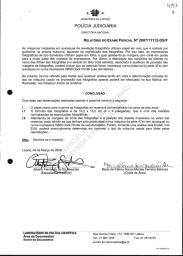|
4156 to 4159-Report of
expert examination |
|
Processos Vol
XVI Pages 4156 to 4158 |
|
TRANSLATIONS BY INES |
|
16_VOLUMEXVIa_Page_4156 |
 |
|
16_VOLUMEXVIa_Page_4157 |
 |
|
16_VOLUMEXVIa_Page_4158 |
 |
|
16_VOLUMEXVIa_Page_4159 |
 |
Report of Forensic Examination Nš
2007/11112/DS - F
Requesting Entity: DIC Portimao PJ
Correspondence nš 2663 of 2007-07-27
Material received on: 2007-07-27
Examination initiated on: 2008-03-03
Total pages: 3
Material for examination.
Four photographs of a female child,
aged 3 - 4 years, wearing a short
sleeved pink shirt with white spots,
in two different poses (two photos
of each pose). Note : PT = posicao.
Requirements
Examination of the photographs to
determine the following:
1. Age of the photos, from the age
of the paper and/or the ink used
2. In what kind of machine is the
paper of the photos used (machine
for rolled or cut paper).
3. How are the photographs cut, by
guillotine or other.
4. If the sizes (of the photos) are
standard.
5. If the developing or printing of
the photos was done in Portugal or
in another country.
Observations and tests carried
out.
The examination was carried out in
accordance with the current
procedures of the Documents Area of
this laboratory.
Observation of the document(s) using
adequate technical means
(stereoscopic magnifying glass,
spectral video comparing equipment
with different kinds of illumination
and different wave compression) to
search for the printing methods,
analysis of the cut margins and
other eventual details.
It was confirmed that these were
reproductions produced on Kodak Xtra
Life photographic paper, printed by
pigment sublimation. It was also
noted that the sets of the Kodak
Xtra Life markings on the back of
the photos are presented at the
edges of the photos (see image on
page 3). The size of the photos is
10,2 x 15,2 cm (4 by 6 inches) which
is one of the standard sizes in
photographic reproduction and the
cut margins are continuous (see
image on page 3).
Given the specific nature of the
requirements and the type of
document in question (photos printed
by pigment sublimation on special
Kodak paper) and the non- existence
of analytical methods that enable
the dating of this kind of document
by means of the analysis of "inks"
we also consulted that company's
representative in Portugal.
In this way, it was possible to
ascertain that the type of paper
that the photographs were reproduced
on has been commercially available
for almost two years, having
replaced Kodak Picture Maker paper,
both for use in photographic
development booths as for domestic
printers.
The machines installed in
photographic development booths use
rolled paper which is cut by the
machine's own guillotine, for the
reproduction of photos. On the other
hand, domestic photo printers use
sheets of paper, which have margins
that are cut by perforation in the
case of most models of printers.
Lastly, the positioning of the
markings on the back of the photos,
could indicate that these were
printed on a series 47xx machine (in
a booth) or using a G600 Dock
printer (domestic use).
However, we were told by Kodak that
any analysis for the concrete
determination of the type of machine
used in the printing of the photos,
could only be done at their factory
in Rochester, US.
Conclusions
Based upon the observations made it
is only possible to include the
following:
1. The paper used to print the
photos in question has been
commercially available for almost
two years.
1.1. The format of the photos is of
10,2 x 15,2 cm (4 by 6 inches) which
is a standard size for photographic
reproductions.
1.2. With regard to the cut margins
of the photos and the position of
the markings on the back, it could
be said that they were produced
using a 47xx series machine (in a
booth) or using a domestic type G200
Dock printer. However, only an
analysis by Kodak, in the US, could
eventually determine concretely the
type of machine used to obtain these
reproductions.
Observations: Return the material.
Lisbon, 4th March 2008.
--
Image of the back of the photos
received, obtained using natural
illumination, from which the Kodak
Xtra Life markings are visible,
positioned at the edges of the
paper.
Image of the inferior right corner
of the back of one of the photos
received, amplified 7.51x and
obtained with natural illumination
from which the regular contours of
the cutting of the photograph are
visible.
|
|
|